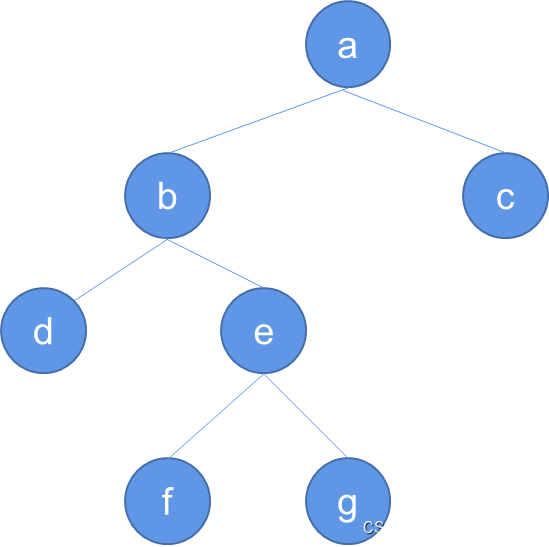【数据结构】树与二叉树(十四):二叉树的基础操作:查找给定结点的父亲(算法Father )
【数据结构】树与二叉树(十四):二叉树的基础操作:查找给定结点的父亲(算法Father )

5.2.1 二叉树
二叉树是一种常见的树状数据结构,它由结点的有限集合组成。一个二叉树要么是空集,被称为空二叉树,要么由一个根结点和两棵不相交的子树组成,分别称为左子树和右子树。每个结点最多有两个子结点,分别称为左子结点和右子结点。

二叉树性质
引理5.1:二叉树中层数为i的结点至多有
个,其中
。
引理5.2:高度为k的二叉树中至多有
个结点,其中
。
引理5.3:设T是由n个结点构成的二叉树,其中叶结点个数为
,度数为2的结点个数为
,则有
。
- 详细证明过程见前文:【数据结构】树与二叉树(三):二叉树的定义、特点、性质及相关证明
满二叉树、完全二叉树定义、特点及相关证明
- 详细证明过程见前文:【数据结构】树与二叉树(四):满二叉树、完全二叉树及其性质
5.2.2 二叉树顺序存储
二叉树的顺序存储是指将二叉树中所有结点按层次顺序存放在一块地址连续的存储空间中,详见: 【数据结构】树与二叉树(五):二叉树的顺序存储(初始化,插入结点,获取父节点、左右子节点等)
5.2.3 二叉树链接存储
二叉树的链接存储系指二叉树诸结点被随机存放在内存空间中,结点之间的关系用指针说明。在链式存储中,每个二叉树结点都包含三个域:数据域(Data)、左指针域(Left)和右指针域(Right),用于存储结点的信息和指向子结点的指针,详见: 【数据结构】树与二叉树(六):二叉树的链式存储
5.2.4 二叉树的遍历
- 遍历(Traversal)是对二叉树中所有节点按照一定顺序进行访问的过程。
- 通过遍历,可以访问树中的每个节点,并按照特定的顺序对它们进行处理。
- 对二叉树的一次完整遍历,可给出树中结点的一种线性排序。
- 在二叉树中,常用的遍历方式有三种:先序遍历、中序遍历和后序遍历。
- 这三种遍历方式都可以递归地进行,它们的区别在于节点的访问顺序。
- 在实现遍历算法时,需要考虑递归终止条件和递归调用的顺序。
- 还可以使用迭代的方式来实现遍历算法,使用栈或队列等数据结构来辅助实现。
- 遍历是二叉树中基础而重要的操作,它为其他许多操作提供了基础,如搜索、插入、删除等。

1-3 先序、中序、后序遍历递归实现及相关练习
【数据结构】树与二叉树(七):二叉树的遍历(先序、中序、后序及其C语言实现)
4. 中序遍历非递归
【数据结构】树与二叉树(八):二叉树的中序遍历(非递归算法NIO)
5. 后序遍历非递归
【数据结构】树与二叉树(九):二叉树的后序遍历(非递归算法NPO)
6. 先序遍历非递归
【数据结构】树与二叉树(十):二叉树的先序遍历(非递归算法NPO)
7. 层次遍历
【数据结构】树与二叉树(十一):二叉树的层次遍历(算法LevelOrder)
5.2.5 二叉树的创建
1. 先序创建
由二叉树的遍历,很容易想到用遍历方法去创建二叉树,我们考虑从先根遍历思想出发来构造二叉树:
【数据结构】树与二叉树(十二):二叉树的递归创建(算法CBT)
2. 复制二叉树
考虑用后根遍历思想递归复制二叉树的算法CopyTree:
【数据结构】树与二叉树(十三):递归复制二叉树(算法CopyTree)
5.2.6 二叉树的基础操作
1. 查找给定结点的父亲
- 递归思想
- 给定结点是指给定的是一个指向某个结点的指针(比如p)。
- 返回值也应该是指针,指向结点p之父亲的指针(找不到时为空)。
a. 算法Father

b. 时间复杂度
在递归实现的二叉树查找父亲的算法中,每个节点都要进行一次判断,最坏情况下,每个节点都需要被访问一次,所以时间复杂度是 O(n),其中 n 是二叉树的节点数。 三叉链表是二叉树的一种存储结构,其中每个节点包含指向其左孩子、右孩子和父亲节点的指针。这种存储结构确实提供了在 O(1) 时间内访问父亲节点的能力。但请注意,这样的存储结构会占用更多的空间,因为每个节点需要额外的指针来存储父亲节点的地址。
- 选择使用哪种存储结构通常取决于对时间和空间的权衡。
- 如果空间要求比较敏感,并且不需要频繁访问父亲节点,那么递归实现可能是一个合理的选择。
- 如果你需要高效地进行父亲节点的访问,并且可以接受更多的空间开销,那么三叉链表可能更适合。
c. 代码实现
struct Node* findFather(struct Node* root, struct Node* p) {
if (root == NULL || p == NULL) {
return NULL;
}
if (root == p) {
return NULL;
}
if (root->left == p || root->right == p) {
return root;
}
struct Node* leftResult = findFather(root->left, p);
if (leftResult != NULL) {
return leftResult;
}
return findFather(root->right, p);
}递归流程:
- 如果树为空或者给定结点为空,则返回NULL
- 如果给定结点是根节点,则根据定义返回NULL
- 如果给定结点是根节点的左孩子或右孩子,则根节点就是其父亲
- 在左子树中递归查找
- 左子树为空,则返回NULL
- 左子树的根节点必然不是给定结点,pass
- 在左子树的左子树中递归查找
- …………
- 在右子树的右子树中递归查找
- …………
- 在右子树中递归查找
- …………
2. 代码整合
#include <stdio.h>
#include <stdlib.h>
// 二叉树结点的定义
struct Node {
char data;
struct Node* left;
struct Node* right;
};
// 创建新结点
struct Node* createNode(char data) {
struct Node* newNode = (struct Node*)malloc(sizeof(struct Node));
if (newNode == NULL) {
printf("Memory allocation failed!\n");
exit(1);
}
newNode->data = data;
newNode->left = NULL;
newNode->right = NULL;
return newNode;
}
struct Node* CBT(char data[], int* index, char tostop) {
char ch = data[(*index)++];
if (ch == tostop) {
return NULL;
} else {
struct Node* t = createNode(ch);
t->left = CBT(data, index, tostop);
t->right = CBT(data, index, tostop);
return t;
}
}
// 查找给定结点的父亲节点(递归实现)
struct Node* findFather(struct Node* root, struct Node* p) {
// 如果树为空或者给定结点为空,则返回NULL
if (root == NULL || p == NULL) {
return NULL;
}
// 如果给定结点是根节点,则根据定义返回NULL
if (root == p) {
return NULL;
}
// 如果给定结点是根节点的左孩子或右孩子,则根节点就是其父亲
if (root->left == p || root->right == p) {
return root;
}
// 在左子树中递归查找
struct Node* leftResult = findFather(root->left, p);
if (leftResult != NULL) {
return leftResult;
}
// 在右子树中递归查找
return findFather(root->right, p);
}
int main() {
// 创建一棵二叉树
char tostop = '#';
char input_data[] = {'a', 'b', 'd', '#', '#', 'e', 'f', '#', '#', 'g', '#', '#', 'c', '#', '#'};
int index = 0;
struct Node* root = CBT(input_data, &index, tostop);
// 需要找到父亲的结点,比如 'e'
// struct Node* targetNode = root->left->right;
struct Node* targetNode = root;
// 调用函数查找父亲节点
struct Node* fatherNode = findFather(root, targetNode);
// 输出结果
if (fatherNode != NULL) {
printf("The father of '%c' is '%c'\n", targetNode->data, fatherNode->data);
} else {
printf("'%c' is either the root or not found in the tree.\n", targetNode->data);
}
return 0;
}


